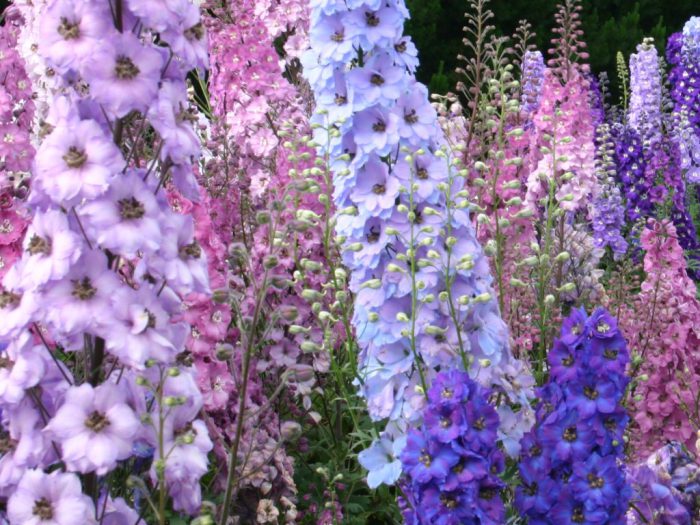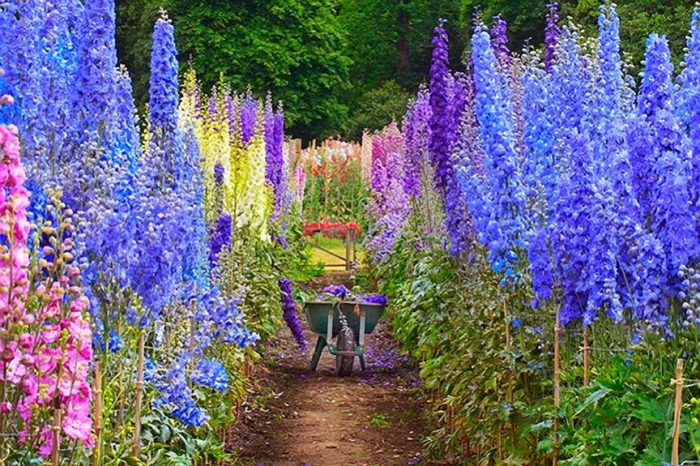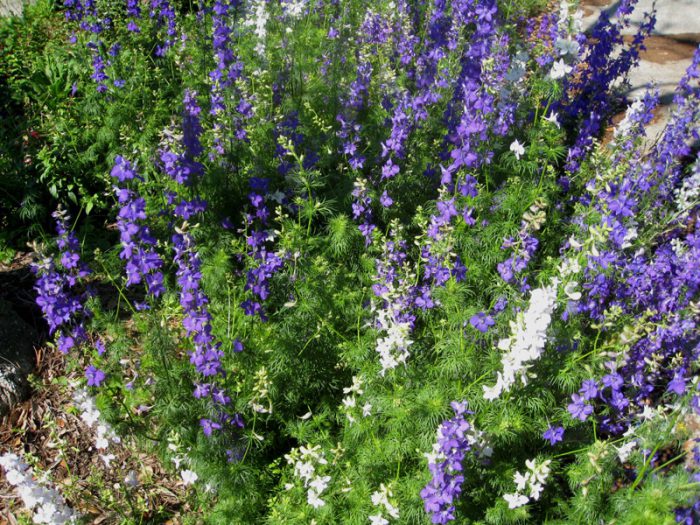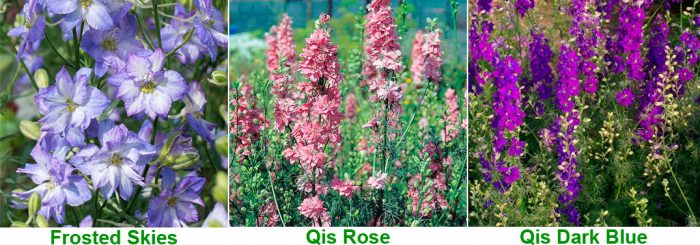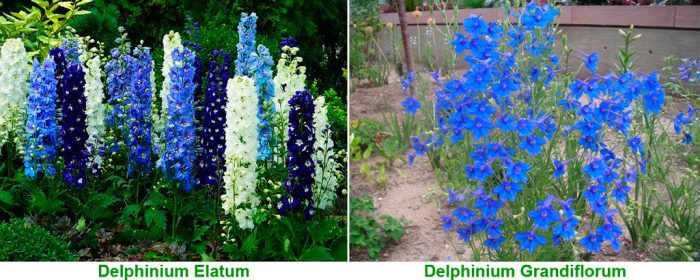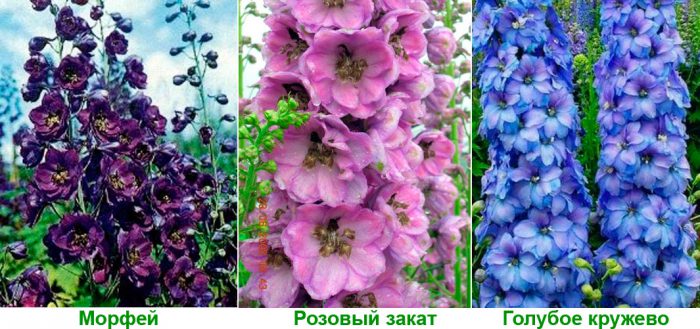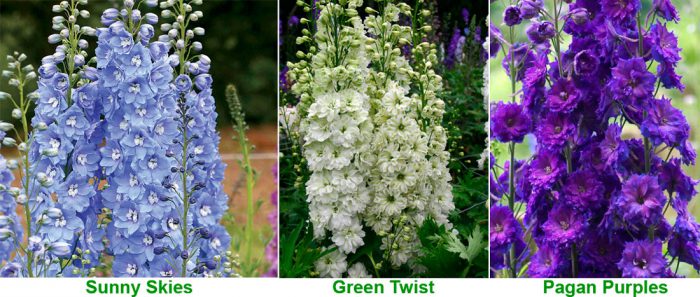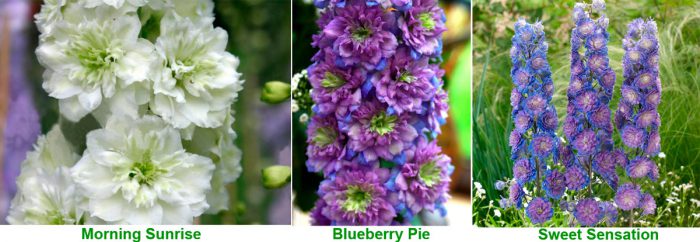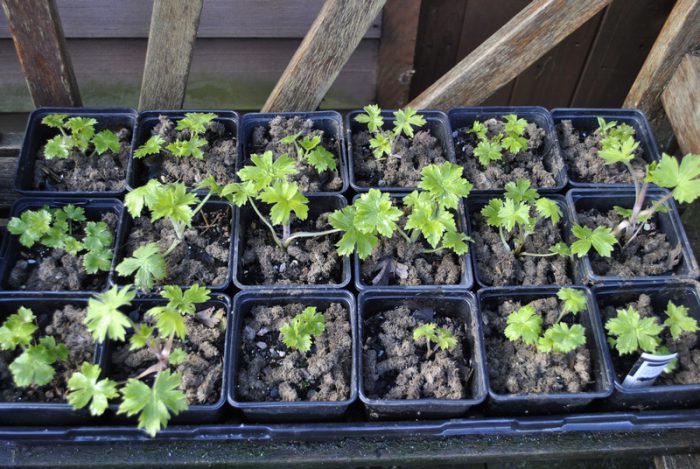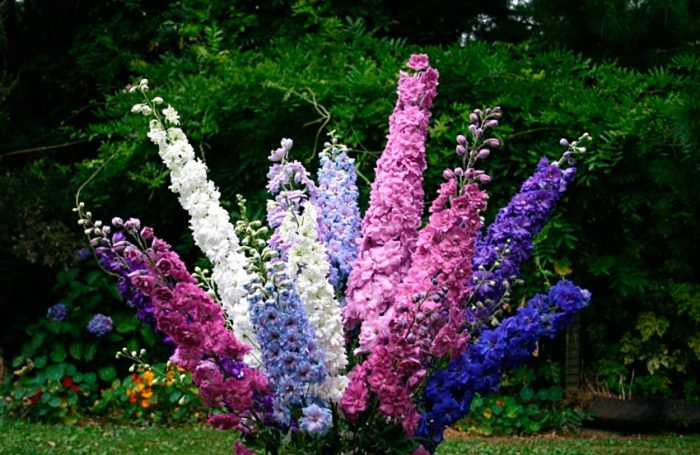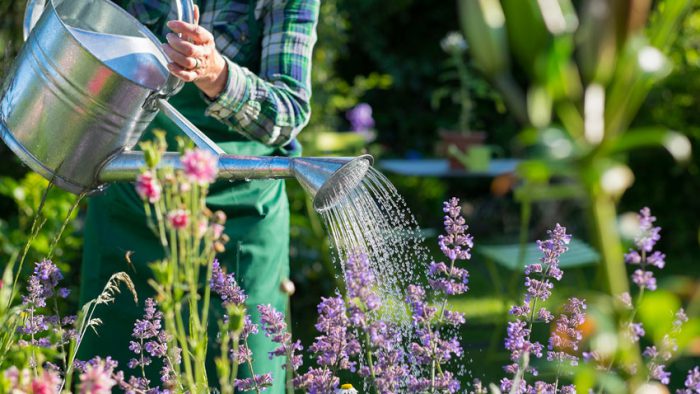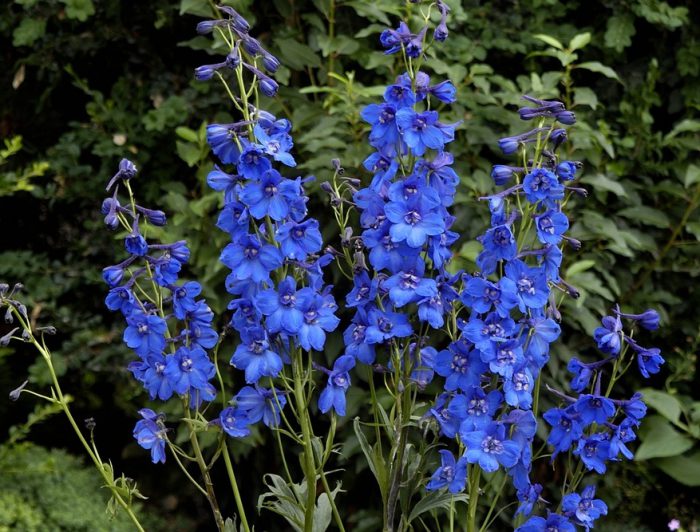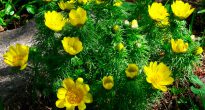A herbaceous plant such as delphinium (Delphinium) is directly related to the buttercup family. It is also called larkspur or larkspur. This genus is represented by annuals and perennials and comprises about 450 different species. Annual plants, of which there are about 40 species, are sometimes distinguished into an adjacent genus and are called at the same time a pick (Consolida). In China, about 150 species of delphiniums can be found in nature. They are also found throughout Southeast Asia, in the Southern and Northern Hemisphere, in the mountains of tropical Africa. A large number of people tend to believe that while the flowers are in an unopened state, the inflorescence itself resembles the head of a dolphin, which is why the flower was named so. But it is also believed that the delphinium was named after the ancient Greek city of Delphi, because a lot of them grew in it. This plant has gained immense popularity among gardeners.
Content
Features of the delphinium
Growing this beautiful flower is not easy and you need some knowledge to do this. As for the choice of a site for planting, then before lunch it must be illuminated by the sun and not be exposed to strong gusts of wind. And it should also be placed in a place where there is no stagnation of water, since rot may appear on the plant because of this. When the plant is planted, the surface of the soil must be sprinkled with a layer of mulch (humus or peat). Such flowers in the same place can be cultivated no longer than 5-6 years, while the Pacific species - no more than 3-4 years. After that, the bushes need to be dug, divided and planted. Their hollow shoots need to be tied up several times per season, because they can be injured by gusts of wind. This plant can get sick with powdery mildew, and harmful insects can also settle on it. In the event that if you take care of the delphinium correctly, then you can admire its spectacular and rather abundant flowering in June. The plant blooms a second time in August or September, but this time the flowering period does not last long.
The main types and varieties with photos and names
There are delphiniums annuals and perennials. The most popular annuals are the Ajax delphinium and the field delphinium.
Field delphinium (Delphinium Consolida)
Such a flower is distinguished by the fact that it can reach a height of 2 meters.Inflorescences consist of double or simple flowers, which can be colored white, blue, pink, and lilac. It has been grown since 1572. The most beautiful varieties are considered: Frosted sky - the central part of its blue flowers is painted white, Qis rose - flowers are light pink, as well as Qis dark blue - with dark blue flowers. Flowering begins in the first days of summer and continues until the onset of the autumn period.
Delphinium Ajax
Such a hybrid plant was created by crossing the Eastern delphinium and the Doubtful delphinium, and he received their best qualities from them. The height of the shoots varies from 40 to 100 centimeters. Heavily dissected leaf plates are practically sessile. The length of the spike-shaped inflorescences reaches 30 centimeters, the flowers can be painted in various colors: red, pink, white, purple, blue, and also blue. There are varieties with dense double flowers. There are dwarf varieties, for example, Dwarf Hyacinth-flowered - the bush reaches a height of 30 centimeters and has double flowers of pink, white, purple, and also raspberry color. Flowering of this variety begins in July and continues until frost.
Perennials began to cultivate delphiniums in the 19th century. Breeders, crossing the first perennial plants tall delphinium (Delphinium Elatum) and large-flowered delphinium (Delphinium Grandiflora), received several first hybrid plants, namely: Barlow's delphinium (Delphinium Barlowii), beautiful delphinium (Delphinium Formosum) and Delphinium belladonna (Delphinium belladonna) Later, the French breeder V. Lemoine bred perennial varieties with double flowers of blue, purple, and lavender colors, and they were called "hybrid" (Delphinium hybridum) or beautiful (Delphinium Ornatum), and after a while they began to be called "cultural" (Delphinium cultorum). To date, the flowers of the perennial delphinium can be painted in a variety of color shades, of which there are about 800. There are low-growing, tall and medium-sized varieties, the flowers of which can be super-double, double, simple and semi-double, and their diameter can be 2-9 centimeters ...
Perennial hybrid plants are divided into groups according to their place of origin. The most popular are New Zealand delphiniums (New Millennium Delphiniums, or New Zealand Hybrids), Scottish (F1 hybrids) and Mafin hybrids, named after the Mafino state farm. Each of the groups has its own distinctive features and positive aspects. For example, the Marfinsky ones have a very beautiful appearance, and are also distinguished by excellent frost resistance, they also have rather large semi-double flowers with eyes painted in a rich contrasting color (varieties: Morpheus, Pink Sunset, Blue Lace, Spring Snow "). However, seeds are not suitable for growing a Marfin delphinium, because in this case varietal characteristics are not preserved.
More recently, a New Zealand group has been formed. The plants included in it are quite tall and can reach a height of about 220 centimeters. They are quite large (about 7-9 centimeters in diameter), double or semi-double. There are types with corrugated petals. These hybrid plants are frost-hardy, disease-free, and durable and ideal for cutting. In this regard, these delphiniums at this moment are most popular with gardeners. In the event that you trade in fresh flowers, then New Zealand delphiniums can bring good profits. Most popular varieties: Sunny Skies, Green Twist, Pagan Purples, Blue Lace, Sweethearts.
T. Cockley became the creator of the hybrid Scottish perennial delphiniums. These hybrid plants have double and super-double flowers with very dense inflorescences. In some cases, it grows up to 58 petals per flower. The bush has a height of about 110-150 centimeters, while the length of the inflorescence is 80 centimeters. Flowers can be painted in a wide variety of colors. They are durable, unpretentious in care and, when grown from seeds, retain the characteristics of the parent plant.The most popular varieties are Morning Sunrise, Blueberry Pie, Moon Light, Sweet Sensation, Crystal Delight and Deepest Pink.
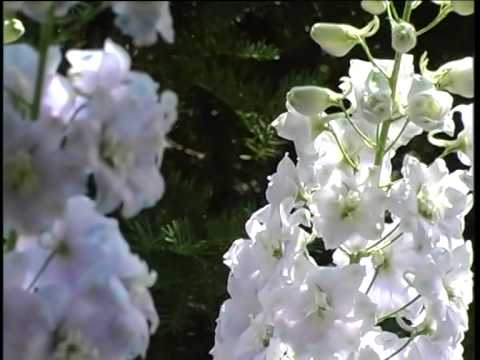

Watch this video on YouTube
Growing a delphinium from seeds
Sowing
Growing a delphinium from seeds is much cheaper and easier than purchasing ready-made planting material. In addition to seeds, this plant can be propagated by buds, dividing the bush and cuttings.
Sowing seeds should be done in the last days of February. It should be borne in mind that if the seeds were kept warm and at low humidity, then their germination can be quite low. For storage, fresh seeds are recommended to be placed on the refrigerator shelf, or they can be sown immediately after collection.
Before sowing, it is necessary to disinfect the seeds. They are poured into a bag made of gauze and placed for a third of an hour in a solution of manganese potassium, the color of which should be dark pink. Also, a fungicidal agent is suitable for this purpose, while the solution is prepared according to the instructions attached to it. Without getting the seeds out of the bag, you need to rinse them thoroughly in running cold water, and then immerse them in an epin solution for 24 hours (2 drops of the product for half a glass of water). Then the seeds need to be dried.
To prepare a suitable soil mixture, you need to combine garden soil, peat, compost (humus) and washed sand in a ratio of 2: 2: 2: 1. Sift well. In order for the substrate to be looser and more moisture-consuming, it is recommended to pour a little perlite into it, namely, ½ part of a glass of substance is taken for 5 liters of soil. Then the mixture is heated for 60 minutes in a water bath for sterilization. Pour the prepared soil into a container intended for sowing and tamp it lightly.
Sow seeds by spreading them over the soil surface. In order not to confuse varieties, attach a decal with the name and sowing date to the container. Pour a 3 mm layer of substrate over the seeds and tamp it lightly. Pour very carefully (using a spray bottle) using cold boiled water. Cover the container on top with a lid, which must be transparent, and lay a black film (covering material) on top of it. The fact is that in the dark, seedlings will appear much faster. Place the container on the windowsill next to the glass. Seeds germinate best at a temperature of 10-15 degrees. In order to significantly increase the germination of seeds, it is recommended to place the container 3-4 days after sowing on a glassed-in balcony or on a refrigerator shelf (frosts to minus 5 degrees are not dangerous for them). After half a month, the container is again transferred to the window. Wait 7-14 days, and you will see the first shoots, after which it is imperative to remove the shelter from the container. It is systematically necessary to irrigate, preventing the soil from completely drying out, as well as to ventilate the crops, while removing condensate.
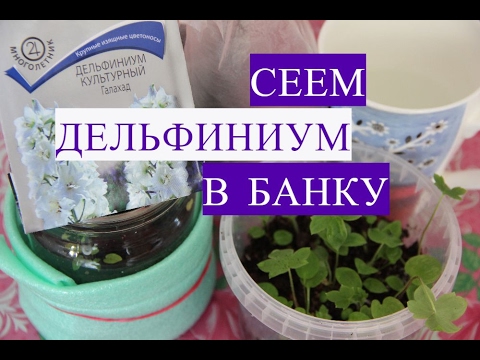

Watch this video on YouTube
Seedling
If the sprouts are healthy, they are dark green, powerful, and the cotyledons have a characteristic sharpening. After the formation of 2-3 true leaf plates, a pick is made in containers, the volume of which should be equal to 200-300 milligrams. After that, they should be grown at a temperature of no more than 20 degrees. The soil needs a loose and well-permeable air. Watering should be done carefully and extremely moderately, the fact is that waterlogging can contribute to the appearance of a disease such as black leg. From the first days of May, it is necessary to begin to accustom the seedlings to the outdoor air, for this, when the window for ventilation is opened, the container with the plants is not removed from the windowsill. Delphiniums should also be taught to sunlight. To do this, they need to be placed in a sunlit place for a while.Seedlings should be fed 1 or 2 times at intervals of half a month, for this use "Solution" or "Agricola", while making sure that fertilizer does not fall on the surface of the leaves. When the seedlings grow up, they should be transplanted into open soil. Moreover, when the clod of earth is completely braided by the roots, it will be very easy to remove it from the container.
Landing in open ground
After the frost stops, you can start planting delphiniums in the garden. At the same time, do not forget that a site suitable for planting in the morning must be illuminated by the sun, and no stagnation of water should occur in the soil. A distance of 60 to 70 centimeters should be maintained between the bushes, while a hole should be prepared that has a half-meter depth and a diameter of about 40 centimeters. In each hole, you need to pour ½ part of a bucket of compost (humus), a couple of large spoons of complex fertilizer, and a full glass of wood ash. Then everything must be mixed with the soil so that the fertilizers do not end up on the root system of the plant, as they can leave a burn. After that, you need to transplant the delphinium sapling into a pre-prepared hole, sprinkle it with soil and tamp it. Water the plant. For the first time, it is recommended to cover the plant with a cut plastic bottle or glass jar for better rooting. After it begins to actively grow, the shelter must be removed.
Delphinium care
After the stems of the plant grow to 10-15 centimeters, it will be necessary to feed with a solution of cow dung (for 5 adult bushes - mix 100 liters of water with 1 bucket of fertilizer). After weeding and loosening the soil, sprinkle its surface with a layer of mulch (peat or humus), which should be about 3 centimeters. After the shoots grow to 20-30 centimeters, it is necessary to thin out the bushes. So, you need to choose from 3 to 5 strong stems, and remove the rest, while the inflorescences will become much larger and more effective. It is necessary to remove less strong stems, while they need to be broken off or cut off at the surface of the ground. Also, this procedure contributes to the protection of the bush and better ventilation. Trim cuttings can be planted for rooting, but only those that are cut at the heel and are not hollow. It is necessary to process the cut with a mixture consisting of a crushed tablet of heteroauxin and charcoal. The cutting is planted in sand mixed with peat, and covered with a film on top. Rooting of the cuttings will occur in 3-6 weeks, and after half a month it can be planted in open soil.
After the bush grows up to 40-50 centimeters, 3 slats (support rods) should be carefully dug in around it, the height of which should be 1.8 m. in case of strong gusts of wind, they will not cut into the stem. When the shoot is 1–1.2 m high, it will need to be tied up a second time.
During the intensive growth period, each bush requires approximately 6 buckets of water. If the summer period is dry, then once every 7 days, 20-30 liters of water should be poured under each bush. After the soil has dried, its top layer must be loosened to a depth of 3 to 5 centimeters. When the inflorescences are forming, the plants should be well-watered. If there is intense heat in this period, gaps (areas on which there are no flowers) may appear on the inflorescences. To prevent this, it is necessary to water the delphinium abundantly, as well as feed it with phosphorus-potassium fertilizer (20 g of substance per 10 liters of water). Take 1 liter of nutrient solution per bush.
From the middle of the summer period, the delphinium can get sick with powdery mildew (a whitish bloom appears on the foliage, which eventually becomes brown). In case of delay, the entire part of the flower above the ground can die off.If there is a suspicion that the plant is infected, then it should be treated with a solution of foundationol or "Topaz" (2 times at intervals). On the leaves, specks of black color may appear, which diverge from the bottom of the bush to the top. So, black spot appears. It can be cured only at the very beginning of development. To do this, you need to make a two-fold treatment of the plant with a tetracycline solution (1 tablet per 1 liter of water). When annular spotting appears, the leaf plates are covered with yellow spots. Such a viral disease is incurable; the flower must be destroyed as soon as possible. The carrier of such a virus is aphid, and therefore, for preventive purposes, it is recommended to treat flowers with a solution of actellik or karbofos. An insect such as the delphinium fly produces a clutch of eggs in the flowers of the plant, and the flower can also damage the slugs. They get rid of flies with insecticidal agents, and you can scare away slugs with the help of jars placed between the bushes and filled with bleach.
When flowering ends, the inflorescences need to be cut off and, if necessary, the collection of seeds. Then young stems appear and in the autumn, repeated flowering is observed. Between the 1st and 2nd flowering, you can divide the bush (in the last summer or first autumn days). In this case, the bush must be older than 3-4 years. The plant is dug up and carefully cut with a sharp knife or separated. When doing this, make sure that the renewal kidneys are not damaged. Treat the cut with wood ash and plant the cuttings.
Delphinium after flowering
When the leaves of the faded plant dry up, the shoots must be cut to a height of 30–40 centimeters from the soil surface. In this case, it is recommended to coat the top of a hollow shoot with clay, which will prevent liquid from entering it and the formation of rot in the root system. Almost all species of delphinium are frost-resistant (both young and adult specimens). If the winter period is snowy and frosty, then the delphinium should be covered with straw or spruce branches. Delphinium can die only from frequent and abrupt changes in temperature, as high humidity appears, and it rots. To prevent stagnation of water in the soil, at the bottom of the planting pit during planting, you need to pour ½ part of a bucket of sand.

